A leggy aloe vera is something that have to not be left out by using us as gardeners due to the fact it is able to create extra problems for our aloe plant in future like leaves can also flip droopy, heaviness on leaves and it may develop downward or smash from middle. It tells about the flowers overall health conditions whether or not it may be suffering from legginess that may kill an aloe plant. Once we know something is inaccurate about our aloe plant we will check what we are able to do to resolve this problem.
6 Reasons Why Aloe vera is Leggy
Leggy Aloe vera hassle arise while their is low mild, plant overwatered, Bulk up leafy or too tall stem growth can cause legginess in our aloe vera. Succulent like aloe vera is just like many flowers after they do not get hold of enough mild it stretches itself and circulate to a lighter vicinity which has direct mild but at the same time as growing and stretching it lacks the growth of stem/ leaves which makes the plant could not deal with the leaf weight and seems to be aloe plant gets droopy or drops to floor.
| Why is my aloe vera leggy? | How to fix it | Extra precautions |
|---|---|---|
| Overwatering | Adjust the watering frequency and amount | Ensure right drainage in the pot |
| Improper Temperature | Provide ultimate temperature situations | Avoid exposing the plant to severe heat or cold |
| Insufficient Light | Place the aloe plant in a nicely-lit region | Avoid exposing the plant to direct daylight |
| Over-Fertilization | Flush out extra fertilizer from the soil | Follow the encouraged fertilizer dosage |
| Small Container Size | Repot the aloe into a bigger field | Choose a nicely-draining potting mix |
| Container Overcrowding | Separate or repot crowded aloe plant | Provide ok space for root growth |
To restoration the aloe plant legginess you want to provide the plant with an good enough quantity of direct light as sunlight can make its leaves more robust after which it is able to stand well.
Aloe stem too tall and long occurs because of this legginess and then it makes the leaf circulate downward, it cannot tolerate the heavy leaf so it drops off which makes the leaf contact the soil and receives wet. After that pests can easily infest the aloe plant leaves and devour all of the sap and make it soft and dry then the leaf turns into brown and die returned.
here are the 6 causes of leggy aloe vera:
1. Overwatering
One possible reason for leggy aloe vera is overwatering. When developing too tall or bulking, this can be fixed via pruning those stems well timed or repotting aloe to new pot. As you know aloe vera vegetation are succulents tailored to dry climates, with specialised tissues for storing water. When we offer extra water, the roots can emerge as waterlogged, leading to root rot and weakening of the stem. This can bring about aloe vera leggy boom as the plant stretches to locate better conditions.
To restore overwatering, establish a right watering ordinary. Allow the soil to dry out absolutely between waterings, and make certain the pot has drainage holes to save you water from gathering. Remember, aloe vera prefers drier conditions instead of constantly wet soil.
2. Improper Temperature
Temperature performs a important position within the increase of aloe vera. Extreme temperature conditions can motive the plant to lengthen looking for greater favorable conditions, main to leggy aloe vera increase. Improper temperature manipulate can disrupt the plant’s herbal growth styles.
To fix this trouble, hold the right temperature range for your aloe vera. Ideally, the plant flourishes in temperatures among fifty five°F and eighty°F (thirteen°C – 27°C). Avoid exposing it to cold drafts or putting it near heating vents. By offering most beneficial temperature situations, you can save you leggy increase and sell a healthy appearance.
3. Insufficient Light
Insufficient mild can make contributions to leggy aloe vera plant life. Aloe vera requires adequate sunlight for photosynthesis and to keep its compact form. In the absence of sufficient light, the plant may additionally stretch toward the closest light supply, ensuing in aloe vera leggy increase.
To restore this trouble, ensure your aloe vera gets good enough light publicity. Place it close to a south-dealing with window or provide synthetic develop lights for 12-sixteen hours a day. Rotate the plant regularly to make sure even mild distribution. By supplying the important mild, you can prevent legginess and encourage robust growth.
4. Over-Fertilization
While occasional fertilization is useful for aloe vera, overdoing it can cause leggy increase. Excessive fertilizer software can result in fast boom, compromising the plant’s compact appearance. Striking a stability in fertilization is important to avoid stimulating excessive increase.
To restoration over-fertilization, use a properly-balanced, water-soluble fertilizer mainly formulated for succulents. Follow the bundle commands and practice the fertilizer sparingly, usually every few months throughout the active developing season. By presenting suitable fertilization, you may ensure wholesome growth and save you legginess.
5. Small Container Size
Container length performs a considerable position inside the development of aloe vera flowers. If your aloe vera has outgrown its pot, it is able to turn out to be root-certain, leading to leggy aloe vera because the plant struggles to find enough space for its roots. Limited room for root expansion can prevent the plant’s universal fitness and result in too tall stems.
To fix this issue, repot your aloe vera into a bigger box. Choose a pot this is 1-2 inches larger in diameter than the modern-day one, with right drainage holes. Carefully put off the plant from its cutting-edge pot, gently loosen the root ball, and location it in the new box with clean, nicely-draining soil. By offering sufficient area for root increase, you could assist your aloe vera regain its compact shape.
6. Container Overcrowding
Overcrowding of multiple aloe vera flora in one field can contribute to legginess. When plants compete for resources like light, water, and nutrients, they’ll stretch the stem too tall on the lookout for a bonus.
To fix this problem, separate overcrowded aloe vera vegetation into individual bins. Carefully get rid of the flora from the container, lightly untangle the roots, and replant every one in its own pot. This lets in every plant to have sufficient area to develop and prevents legginess caused by overcrowding.
About Aloe Vera :
| Family | Asphodelaceae |
| Scientific Name | Aloe barbadensis miller |
| Native | Arabian Peninsula |
| Other Names | Cape aloe,Aloe plant, Chinese aloe, Barbados Aloe |
| Plant Type | Perennial, Succulent |
| Hardiness zone | 4a to 8b |
| Grown | Pots, Containers, Gardens, |
| Height | 24-forty inches(50-101cm) |
| Growth rate | Slower |
| Soil | Well draining, Fertile |
| Light Requirement | Partial Sunlight, Full Sun(Can Tolerate) |
| Fertilizer | Liquid primarily based |
| USDA hardiness | Zone eight – 11 |
| Blooming Season | Summer |
| Flower Color | Orange, Red, Yellow |
| Leaf Color | Green, Spiky Shape |
| Growth Rate | Slow growing |
| Benefits | For Skin and Body |
| Uses | Cosmetics, pores and skin lotions |
| Toxicity | Mild poisonous |
What does a leggy aloe vera plant look like
A leggy Aloe Vera plant seems like having long, limp, and flattened leaves. This can manifest if the plant does not get sufficient daylight, if the roots are too vulnerable, or in case you water it too much.
Lack of light exposure is one cause of the leggy appearance. Native to desert areas, aloe vera flowers want robust, oblique sunshine to grow. Your aloe will increase its leaves in the direction of the light supply if it would not get enough light, giving them an elongated and stretched-out look. The plant’s structure deteriorates inside the absence of sufficient mild, making it not possible for it to maintain its distinct upright look.
Weak stems are any other element for the leggy growth. Lack of sunshine would possibly result in brittle stems that can’t preserve the weight of the leaves to your aloe vera plant. The plant seems feeble and unattractive because of the drooping and knocking down of the leaves.
Another usual reason for Aloe flop is overwatering. Aloe Vera plant life are drought-tolerant and do no longer fare properly in damp soil, specially inside the winter or chillier months. Root rot and standard plant deterioration may also end result from an excessive amount of moisture in the soil. The leaves may additionally lose their firmness and turn out to be limp and stretched as the roots war to correctly soak up vitamins and water.
It’s crucial to give your aloe vera plant the precise quantity of light if you want to preserve it from becoming leggy. Put it in a niche in which it can get several hours each day of vivid, oblique mild. Make sure the soil has appropriate drainage as properly. You need to also water the plant gently, letting the top inch of soil dry up before the subsequent watering. Check the leaves and stem frequently for any warning signs of extra boom or brittleness, and if vital, take into account supporting the stems.
How to Fix my leggy aloe vera plant?
There are various methods to fix the leggy aloe vera plant:
Pruning
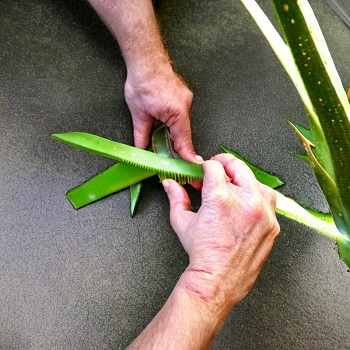
Trimming is the only solution for leggy aloe vera plants because it removes the infected leaf and doesn’t touch the other healthy leaves. It removes the overall problem from root so its effective method which works on all indoor succulent or normal house plant leggy conditions.
Pruning the leggy stems is the best possible solution and your plant can be saved without changing the location or pot. As you cut off the legginess it is able to grow normally. But I highly suggest if your aloe plant doesn’t get sufficient sunlight it will again grow aloe plant leggy stems\leaves , some people say there aloe plants have too tall stem, it is becayse of leginess and not priving the enough light result in droopy, growing aloe sideways.
Fix this aloe vera legginess using pruning and make your plant happy again.
Providing Light Source
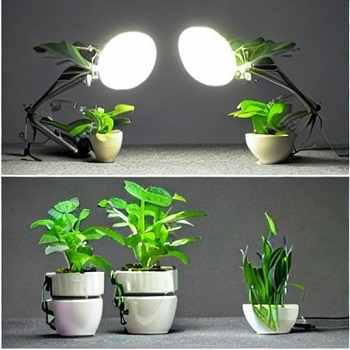
According to iastate.edu ,The most common reason for aloe vera to getting leggy due to not receiving enough light and this condition is called low light. This is due to leaves trying to get a light source so they stretch out the leaves or stem too tall until they get enough light. Yes Aloe plants do adjust to direct sun but get burns if they are placed in for hours a day otherwise in sunlight the aloe leaves are grown very strong and the overall health of the plant can be improved in sunlight, it also grows faster in daylight.
To fix the low light condition in aloe plants that makes this legginess we first need to place the plant in more light source and if you have a window that gets sunlight for 2-4 hours a day it’s great to place it there. Once your plant starts getting sunlight it will grow normally and those leaves that have already become leggy can be trimmed down as there is no way you can get rid of them normally.
Natural Phenomenon
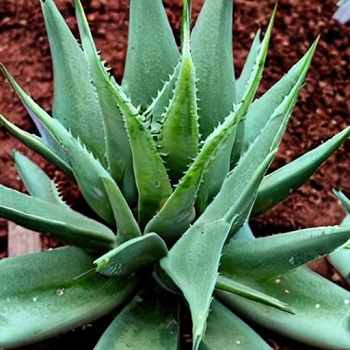
Even if you provide Aloe plants enough sunlight, water, pot they still get legginess then it could be because some plants can become leggy naturally so wherever you place them it might become leggy stem. So the best solution for this problem is to prune the aloe plant leaves that are damaged, watery , soft and let the plant rejuvenate itself again.
Overwatered Plant
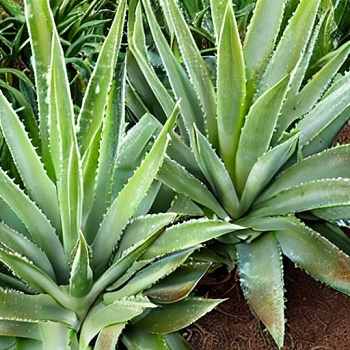
Aloe vera needs moist soil and if you are giving it too much water it can lead to leggy aloe plants as leaves may seem droopy, some could become wet, watery and one or 2 leaves might turn to brown. This aloe vera leginess can make the leaves grow sideways and make it bad by the appearance of aloe vera plants. Even this too much moisture can invite pests that may eat the sap juice and make them have brown spots on leaves or it may be dried.
Overwatered aloe plant legginess can be fixed by lowering the watering or should limit the schedule to water the aloe vera. You should always take care of one thing that does not water aloe vera if it’s damp or fully wet, you can check by inserting your index finger in soil and see if it’s dry. for dry soil put some water and if soil is wet then wait 2 more days.
Locations where an aloe plant gets a good amount of sunlight have zero problem of overwatering while the place where it gets shade most of the time have damp soil or legginess due to overwatering problems.
Aloe vera can also survive in poor soil as well.
Changing Pot

Sometimes legginess in aloe plants occurs due to pot bound and it creates pressure on the aloe vera plant to grow leggy as there is no space to thrive it lowers the growth on the stem and overall growth pattern until they get enough space to spread. Aloe plant roots can spread in one position to another and if some of the leaves are getting leggy and grow sideways or look droopy then it needs a bigger pot to fix this issue.
You can also prune it to reduce the aloe plant size, by taking out the whole plant cutting off some of the bigger leaves and prune the thin roots of aloe will grow the plant normally plant again in the same pot.
What I do if I have the option is I will cut the cut from the base to propagate it in a new pot while the roots are left behind. It can be repotted by cutting bottom roots and letting it grow again on its own.
In starting aloe roots may need moist soil and more water once the roots are established, it will bring out some leaves and start growing again. This way you have 2 plants of aloe vera.
Repot Your Aloe Vera Plant
If your aloe vera is root-bound or in a small container, it’s time to repot it into a larger pot. Select a container that provides ample room for root growth and has drainage holes. Use well-draining soil formulated for succulents and transplant your aloe vera carefully, making sure the roots are spread out.
Adjust the Environmental Temperature
Maintain an optimal temperature range for your aloe vera. Avoid exposing it to cold drafts or extreme temperature fluctuations. Aim for temperatures between 55°F and 80°F (13°C – 27°C) to promote healthy and compact growth.
Can I Cut the Top Off My Aloe Vera?
Yes, you can remove the top portion of your aloe vera plant. In fact, this process, known as beheading, can be beneficial for the plant’s overall growth and appearance. Beheading allows you to propagate your aloe vera and create new plants.
To cut the top off your aloe vera, follow these steps:
- Sterilize your pruning shears with rubbing alcohol to prevent the spread of diseases.
- Identify the section of the plant you want to remove. It could be a leggy stem or the entire top portion.
- Make a clean and precise cut just below a cluster of leaves using the sterilized pruning shears. Ensure that the cut is smooth and straight.
- After removing the top portion, set it aside to dry for a few days. This drying period allows the cut end to form a protective callus, which helps prevent rotting when you propagate it.
- Once the cut end has calloused, prepare a well-draining potting mix suitable for succulents. You can create a mix using cactus soil, perlite, and coarse sand.
- Plant the calloused end of the aloe vera top into the potting mix, burying it about an inch deep. Make sure the soil is lightly moist but not overly wet.
- Place the pot in a bright location with indirect sunlight. Avoid direct sunlight, as it can cause sunburn to the newly propagated top.
- Water the newly planted top sparingly, allowing the soil to dry out between waterings. Overwatering can lead to root rot, so it’s essential to be cautious.
- Within a few weeks, you should start to see new roots and leaves emerging from the cut end of the aloe vera top. This indicates successful propagation.
- Once the new plant has developed a strong root system, you can treat it as a mature aloe vera plant.
Repotting Leggy Aloe Vera
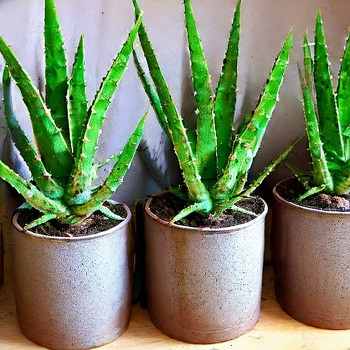
Method to repot leggy aloe vera is done using a wide pot, well draining & fertile soil with good care for the initial days. Aloe vera being leggy is saved by pruning it after that you need to repot the whole plant in a bigger sized pot so aloe can have space to spread properly. Below I would be discussing removing the problem and making 2 aloe vera from a single plant.
Here are steps to repot legginess in aloe vera:
- Find the leggy leaves or too long stem that is bending sideways then you need to cut that stem or leaf and all those that seem limp or fall off downward, this can solve the legginess in aloe plants.
- Now Cut down the aloe plant from the base you may see white portion that is growing roots, you may need to cut from the middle so that it leaves some white portion for the plant and some white portion for the roots. These 2 parts one is the above shoot part and the other one is the roots. Root will eventually grow the plant again while the aloe plant’s above shoot part will be grown on the glass/jar of water for rooting. Once we see roots it can be transplanted to soil.
- If you don’t want 2 separate plants then I suggest pruning the legginess part can solve the problem. Every year you should think about that and provide proper sunlight to your aloe plant.
- Also change the potting mix and replace your pot to a bigger size which will help your plant with a long stem problem as now the aloe plant can spread and grow in a larger pot so no legginess.
- Use a potting mix that works for succulents like aloe. I recommend using cactus and succulents by hoffman. It is well draining and has potential nutrients.
- Put this soil on the new pot and gently take out your aloe plant from the old pot using a trowel, hand rake, and a transplanter. If you don’t have these tools I have brought these you might also need this so here they are the gardening tools.
- Now put the plant in the new pot and give water to the plant so it can recover from the repotting shock. Give it time and place it in shade and move to parietal shade next day.
- It will grow again and enjoy now you have successfully repotted the long stem or leggy stem in aloe vera plant.
How to revive a dying aloe plant?
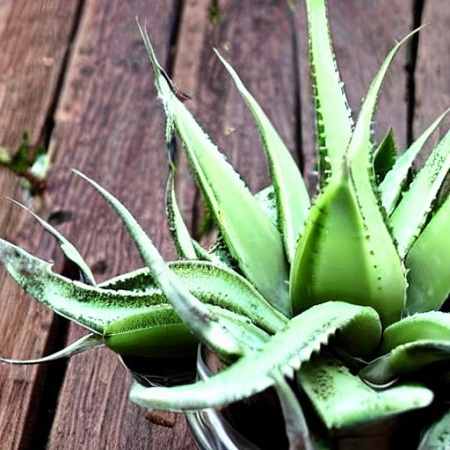
Aloe plants once they start dying it is very hard to revive them because long stems, leggy and bending downwards leaves can result in aloe vera no longer being saved. But If the legginess is only one part of the stem then you have other stems growing that can be repotted to other potting plants. Aloe plants are revived with pruning or repotting into new pots and making sure they get enough sunlight in the future.
Propagation is a simple technique once you know where you need to make a cut and how to propagate it properly.
We simply can’t take leaves of aloe vera and propagate them, but you need to cut from the base where you see the shoot(middle white part of leaf and root section). This can develop roots if taken out with leaves. Even without leaves this part certainly has rooting below on the soil so if you cut the whole plant from above and just leave with the half white shoot it will grow a new plant.
Once you are familiar with the cuttings you can have any problem in aloe vera plants.
Propagating Your Aloe Vera
Propagating aloe vera is a wonderful way to expand your plant collection and share the beauty of this versatile succulent with others. Here are the steps to successfully propagate your aloe vera:
- Select a Healthy Parent Plant: Choose a mature and healthy aloe vera plant from which you will take cuttings for propagation. Look for plants with strong, well-developed leaves.
- Gather the Necessary Tools: Before you begin propagating, gather the required tools. You will need clean and sharp pruning shears or a knife, a clean work surface, and small pots or containers for planting the cuttings.
- Prepare the Cuttings: Carefully select a leaf from the parent plant, preferably one of the outer leaves. Using the sterilized pruning shears or knife, make a clean cut at the base of the leaf, as close to the stem as possible.
- Allow the Cuttings to Dry: After removing the leaves from the parent plant, set them aside in a cool and dry location. Let the cut ends dry for a few days until they form a callus. This callusing process helps protect the cut ends from rotting when planted.
- Plant the Cuttings: Once the cuttings have calloused, prepare small pots or containers with well-draining soil. A mixture of cactus soil, perlite, and sand works well. Create a small hole in the soil and gently insert the calloused end of the leaf into the hole, ensuring it is buried about an inch deep. Leave the top part of the leaf exposed.
- Provide Proper Care: Place the potted cuttings in a location with indirect sunlight. Avoid direct sunlight, as it can scorch the leaves. Water the cuttings sparingly, allowing the soil to dry out between waterings. Overwatering can lead to root rot, so it’s important to be cautious.
- Transplant the New Plants: Once the new plants have developed strong roots and grown a few inches in height, they can be transplanted into individual pots. Choose pots that are slightly larger than the root system, providing room for growth. Use a well-draining succulent potting mix and plant the new plants, ensuring the roots are covered with soil.
- Care for the New Plants: Place the newly transplanted aloe vera plants in a bright location with indirect sunlight. Water them sparingly, allowing the soil to dry out between waterings. As the plants grow, gradually increase their exposure to sunlight.
- Monitor and Maintain: Keep a close eye on the new plants and ensure they receive adequate light, water, and care. Over time, they will develop into mature aloe vera plants, ready to grace your space or be shared with fellow plant enthusiasts.
Remember, propagating aloe vera can be a slow process, and not all cuttings may successfully develop into new plants. However, with patience, care, and the right conditions, you can enjoy the satisfaction of propagating your own aloe vera and expanding your collection.
How do you prune leggy aloe?
Trimming a leggy aloe plant can be done using pruners or cutting tools, with that use rubbing alcohol to clean the sharp blade so your plant don’t touch the disease. Now prune the infected aloe stem/leaf close from the base that’s it and give water to the aloe plant it will recover itself soon. Place the plant in shade initially then move it to partial shade of course now it should get sunlight so it won’t have a legginess this time to remember to place it in direct sunlight where it gets at least 4 hours of light.
Pruning is an effective technique to get rid of leggy aloe plants so if possible do prune your plant whenever you find dried, watery, damaged, diseased stems. Make sure they get enough sunlight and plenty of water.
Aloe vera is nowadays a most popular plant with benefits on skin and health. When it comes to trimming aloe plant you should collect the sap juice from aloe leaves so and apply it for sun burns, dry skin or acne. According to Baylor College of Medicine, These plants contain Vitamin C, A and has anti- anti-inflammatory properties that are beneficial for the human body.
Aloe vera benefits can also be used to prevent the lines and wrinkles but you cannot expect that it would magically turn your skin to younger 20’s. Using it will definitely help but I would personally suggest to do exercise and it helps to slow down the ageing process, but yes we cannot stop it from happening that’s a harsh truth of life.
How to use the gel of aloe plant:
- Cut off one of the aloe vera leaves.
- slice the leaf until you see the transparent gel inside of it.
- You need to peel off all the gel.
- Applying it to the damaged part of skin, it will help the skin to moisturise and recover fast.
There are many products available in the market that use aloe vera gel, if you don’t want to do any slicing or peeling work then just take a look of my recommended products of aloe vera.
Organic Aloe Vera Gel for Face, Skin – Buy
How do I get my aloe plant to grow straight?
We can grow aloe plants straight upwards by providing them with enough sunlight. If we rotate our aloe plant on each side every day then all the spiky leaves can get proper light and it won’t get leggy or grow sideways. You can also fix aloe plant legginess by changing the pot size to 2 inch bigger. It helps the pot to grow newer leaves with that you need to prune some leaves as leggy aloe plants can be fixed with pruning and by providing minimum 2 hours sunlight daily.
Another method is to cut off all the leaves that have legginess, even the leaves that are dried, soft, watery and choose a leaf that is healthy and repot aloe plant again. Yes I am suggesting to make another pot with aloe plants as this plant may get more problems. What I have told you is to provide them with a light source and prune it to save aloe plants but sometimes even if the plant gets sunlight it becomes leggy in that case you can propagate the plant to make a new aloe plant.
Trimming leaves is the best possible way to save leggy aloe plants because we are directly removing the problematic leaves and letting the remaining leaves grow. Again I point out that you make sure to change the location of the aloe plant and place it somewhere it gets sunlight.
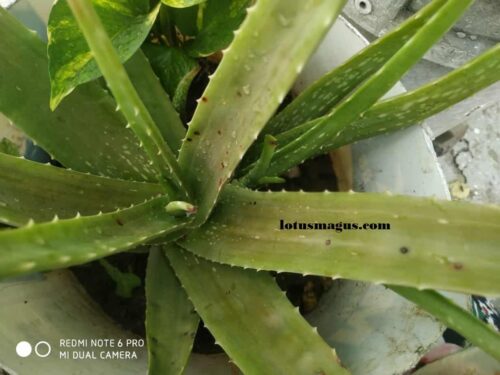
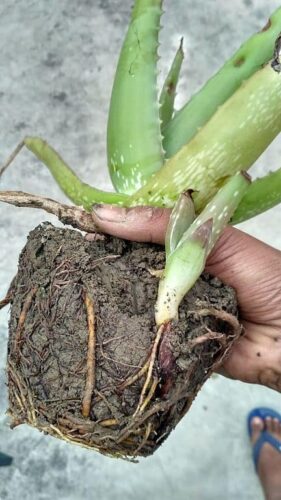
Why won’t my aloe plant stand up?
If your aloe plant can’t stand up because it has developed leggy growth or having too much water causes roots rotting that could lead to droopy, bending down the stem. To fix the aloe plant not standing up problem you can reduce the water intake by aloe vera or provide proper sunlight so it never has a legginess(thin or too tall stem growth).
Stem becoming too tall or long and doesn’t able to stand properly is simply because of legginess and it is solved using pruning and changing location. You need to do both trimming and relocation of the plant as this problem can be crucial and might damage the plant in the long run.
Some people might suggest propagating it but that is the last option you can do as well.
Aloe vera varieties
Aloe vera has more than 400+ species so I am naming the popular ones.
- Aloe Maculata
- Aloe Broomii
- Aloe Ferox
- Aloe Aculeata
- Aloe Perryi
- Aloe Nyeriensis
- Aloe Succotrina
- Aloe Capitata, etc
Aloe plant too tall
If your aloe plant growing too tall then just shorten its leaves because they might be stretching for light source. It’s safe to remove the top half leaf and let it stay like that for a week for the plant to repair the prune damage. This issue is common in aloe plants and this stretching of leaves can be solved by changing the current location of the plant. Try the South Facing Window Area (if not occupied by other things) or find a place which gets lots of indirect sunlight that would be great for our aloe plant.
I would not recommend the cutting in winter months as the plant has slow growth and most get in dormant stage. You should also note not to overwater your aloe vera in November-December months. That time it was too cold, that’s why it is hard for any plant to recover completely.
Aloe plant growing sideways
Aloe plants grow sideways due to low light and where they get some source of light they roll over to that position. Normally they have a circular growth in sunlight and if it’s growing sideways that’s normal until it actually drops to 90 degrees. If the plant came with leaves standing up then it might be searching for light.
And Don’t worry much because aloe vera doesn’t get all straight up, they do grow in narrow form growing sideways with 40 to 70 degree angle with more mature leafy growth. Also the solution is just change the location of your aloe vera and all things would get normal.
Final Words
This problem in aloe plants which are leggy or not standing is not new ,it happens to most plants and with that we deal according to the severity of the issue. You can follow my above guide. I have explained each and every factor with a solution so you may not go to any other place to find aloe plant long stem solution.
Related Posts:
How to Harvest and Use Aloe Vera Gel A Step by Step Guide
32 Types of Aloe Plants – Which One is Best(With Pictures)
The History and Folklore of Aloe Vera Myths Legends and Cultural Significance
A Beginners Guide to Growing Aloe Vera Tips and Tricks for Success
Aloe Vera Flowers Uses and Medicinal Benefits
Is Aloe Vera Flower Luck? – Know The Reason Behind It?
Aloe Vera Meaning (What Does It Symbolize Spiritually In Different Cultures?
Aloe Vera Flowers Uses and Medicinal Benefits
Aloe Vera Plant Care – 5 Tips to Grow Them Indoors
Can You Freeze Aloe Vera Plant – Store and Preserve Gel, Leaf
Plants that Look Like Aloe Vera – 7 Similar Succulent(Pictures)
Can Aloe Vera Grow Without Sunlight? – (How Much Sun Does It Need)
Best Soil for Aloe Vera – Miracle Grow or Regular Potting Mix?
Aloe Humilis (Spider Aloe) – Care, Propagation, Benefits
Why Your Aloe Plant Fell Apart: Overwatering and How to Fix It
